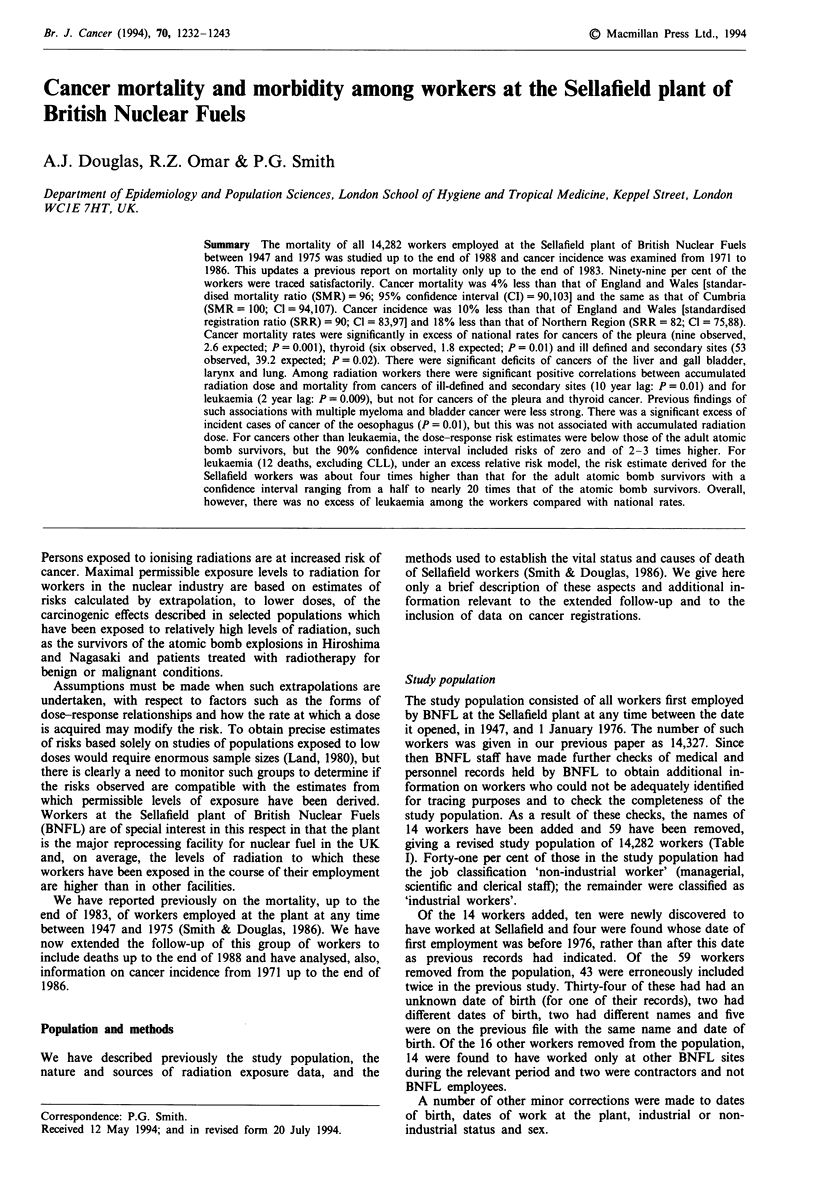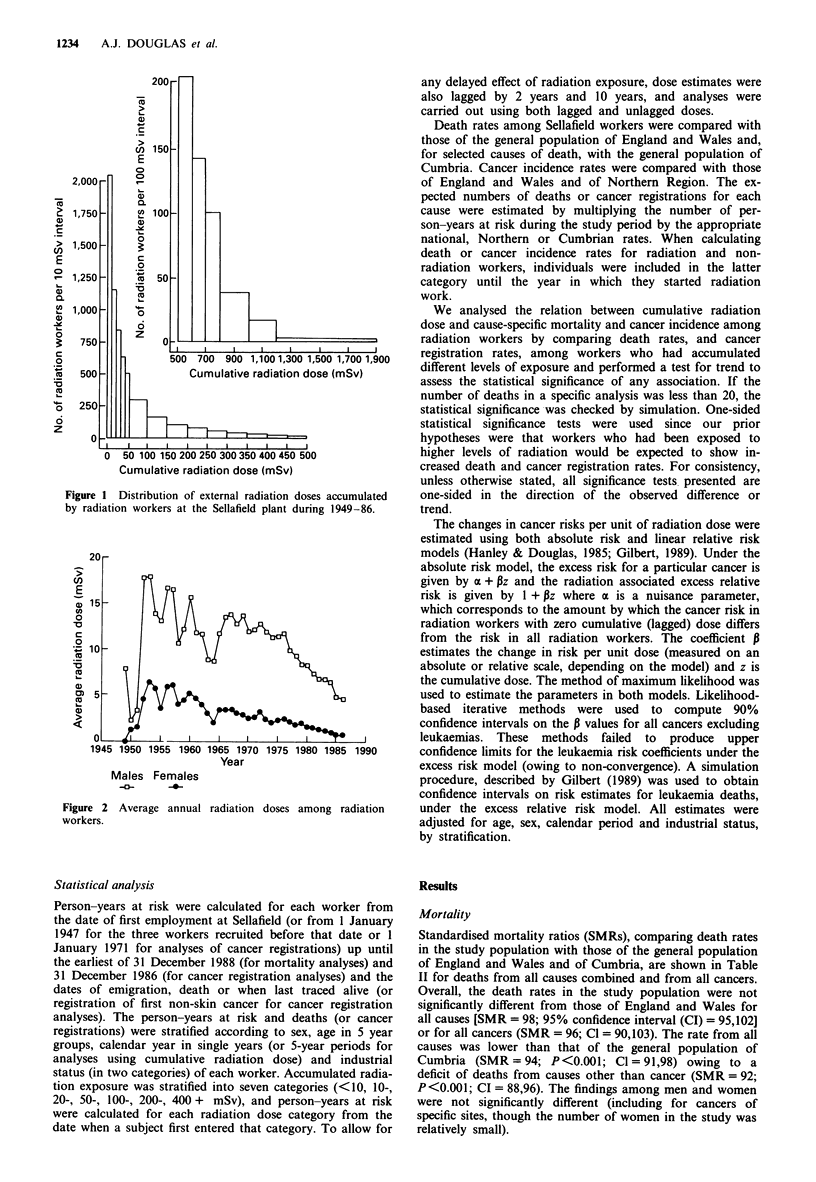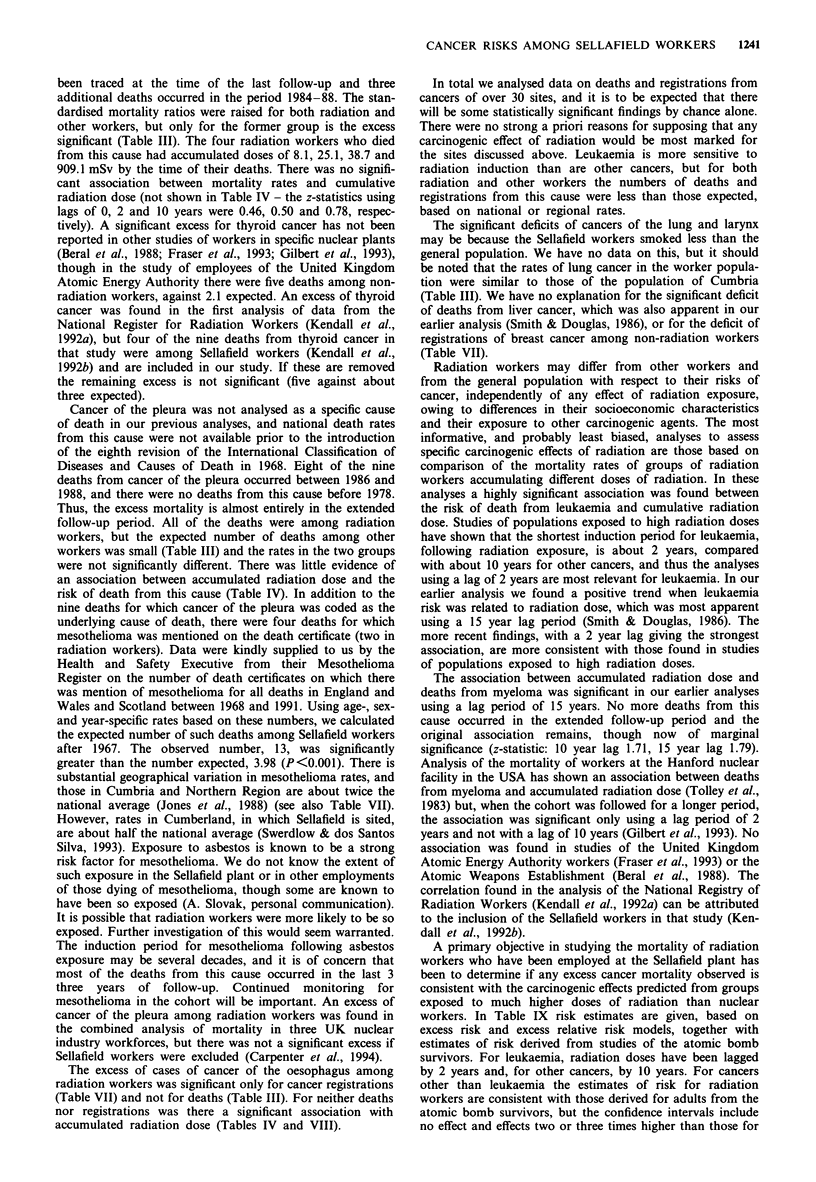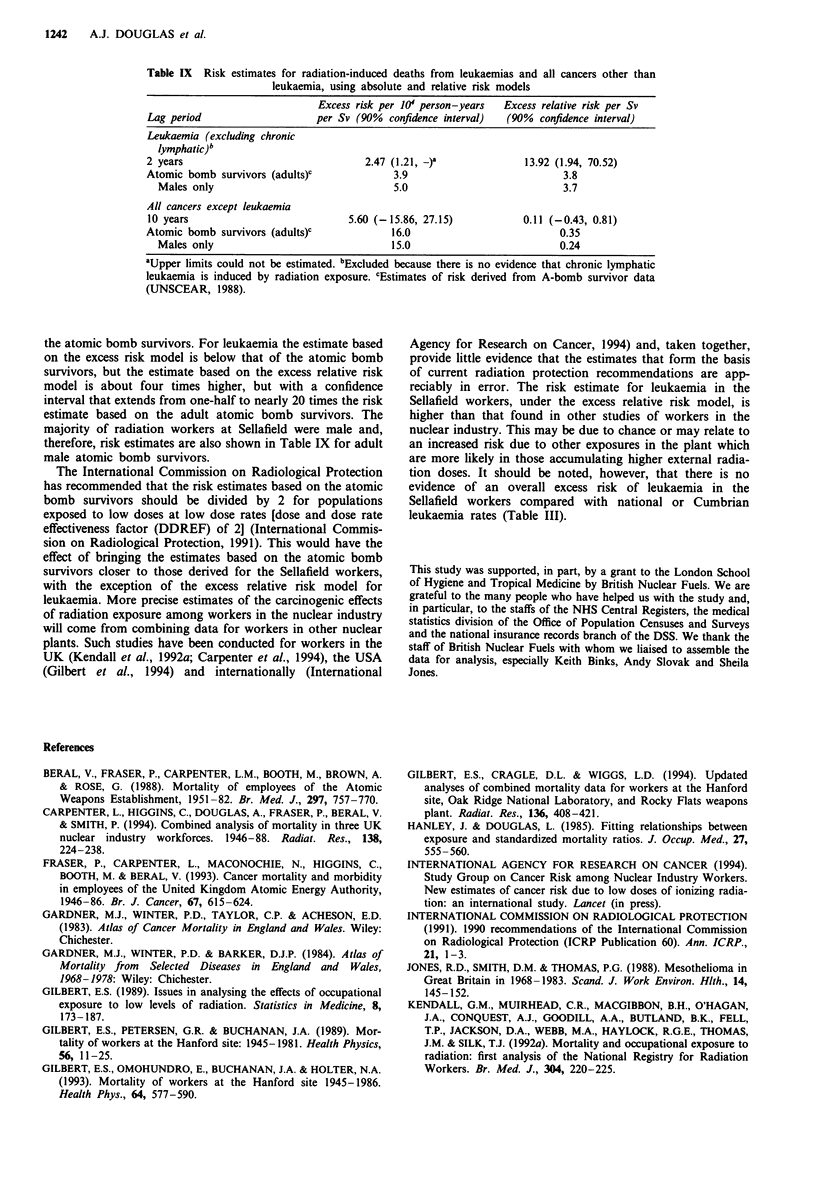Abstract
The mortality of all 14,282 workers employed at the Sellafield plant of British Nuclear Fuels between 1947 and 1975 was studied up to the end of 1988 and cancer incidence was examined from 1971 to 1986. This updates a previous report on mortality only up to the end of 1983. Ninety-nine per cent of the workers were traced satisfactorily. Cancer mortality was 4% less than that of England and Wales [standardised mortality ratio (SMR) = 96; 95% confidence interval (CI) = 90,103] and the same as that of Cumbria (SMR = 100: Cl = 94,107). Cancer incidence was 10% less than that of England and Wales [standardised registration ratio (SRR) = 90; Cl = 83.97] and 18% less than that of Northern Region (SRR = 82; Cl = 75.88). Cancer mortality rates were significantly in excess of national rates for cancers of the pleura (nine observed, 2.6 expected; P = 0.001), thyroid (six observed, 1.8 expected; P = 0.01) and ill defined and secondary sites (53 observed, 39.2 expected; P = 0.02). There were significant deficits of cancers of the liver and gall bladder, larynx and lung. Among radiation workers there were significant positive correlations between accumulated radiation dose and mortality from cancers of ill-defined and secondary sites (10 year lag: P = 0.01) and for leukaemia (2 year lag: P = 0.009), but not for cancers of the pleura and thyroid cancer. Previous findings of such associations with multiple myeloma and bladder cancer were less strong. There was a significant excess of incident cases of cancer of the oesophagus (P = 0.01), but this was not associated with accumulated radiation dose. For cancers other than leukaemia, the dose-response risk estimates were below those of the adult atomic bomb survivors, but the 90% confidence interval included risks of zero and of 2-3 times higher. For leukaemia (12 deaths, excluding CLL), under an excess relative risk model, the risk estimate derived for the Sellafield workers was about four times higher than that for the adult atomic bomb survivors with a confidence interval ranging from a half to nearly 20 times that of the atomic bomb survivors. Overall, however, there was no excess of leukaemia among the workers compared with national rates.
Full text
PDF











Selected References
These references are in PubMed. This may not be the complete list of references from this article.
- Beral V., Fraser P., Carpenter L., Booth M., Brown A., Rose G. Mortality of employees of the Atomic Weapons Establishment, 1951-82. BMJ. 1988 Sep 24;297(6651):757–770. doi: 10.1136/bmj.297.6651.757. [DOI] [PMC free article] [PubMed] [Google Scholar]
- Carpenter L., Higgins C., Douglas A., Fraser P., Beral V., Smith P. Combined analysis of mortality in three United Kingdom nuclear industry workforces, 1946-1988. Radiat Res. 1994 May;138(2):224–238. [PubMed] [Google Scholar]
- Fraser P., Carpenter L., Maconochie N., Higgins C., Booth M., Beral V. Cancer mortality and morbidity in employees of the United Kingdom Atomic Energy Authority, 1946-86. Br J Cancer. 1993 Mar;67(3):615–624. doi: 10.1038/bjc.1993.113. [DOI] [PMC free article] [PubMed] [Google Scholar]
- Gilbert E. S., Cragle D. L., Wiggs L. D. Updated analyses of combined mortality data for workers at the Hanford Site, Oak Ridge National Laboratory, and Rocky Flats Weapons Plant. Radiat Res. 1993 Dec;136(3):408–421. [PubMed] [Google Scholar]
- Gilbert E. S. Issues in analysing the effects of occupational exposure to low levels of radiation. Stat Med. 1989 Feb;8(2):173–187. doi: 10.1002/sim.4780080205. [DOI] [PubMed] [Google Scholar]
- Gilbert E. S., Omohundro E., Buchanan J. A., Holter N. A. Mortality of workers at the Hanford site: 1945-1986. Health Phys. 1993 Jun;64(6):577–590. doi: 10.1097/00004032-199306000-00001. [DOI] [PubMed] [Google Scholar]
- Gilbert E. S., Petersen G. R., Buchanan J. A. Mortality of workers at the Hanford site: 1945-1981. Health Phys. 1989 Jan;56(1):11–25. doi: 10.1097/00004032-198901000-00001. [DOI] [PubMed] [Google Scholar]
- Hanley J., Liddell D. Fitting relationships between exposure and standardized mortality ratios. J Occup Med. 1985 Aug;27(8):555–560. doi: 10.1097/00043764-198508000-00011. [DOI] [PubMed] [Google Scholar]
- Jones R. D., Smith D. M., Thomas P. G. Mesothelioma in Great Britain in 1968-1983. Scand J Work Environ Health. 1988 Jun;14(3):145–152. doi: 10.5271/sjweh.1938. [DOI] [PubMed] [Google Scholar]
- Kendall G. M., Muirhead C. R., MacGibbon B. H., O'Hagan J. A., Conquest A. J., Goodill A. A., Butland B. K., Fell T. P., Jackson D. A., Webb M. A. Mortality and occupational exposure to radiation: first analysis of the National Registry for Radiation Workers. BMJ. 1992 Jan 25;304(6821):220–225. doi: 10.1136/bmj.304.6821.220. [DOI] [PMC free article] [PubMed] [Google Scholar]
- Land C. E. Estimating cancer risks from low doses of ionizing radiation. Science. 1980 Sep 12;209(4462):1197–1203. doi: 10.1126/science.7403879. [DOI] [PubMed] [Google Scholar]
- Smith P. G., Douglas A. J. Mortality of workers at the Sellafield plant of British Nuclear Fuels. Br Med J (Clin Res Ed) 1986 Oct 4;293(6551):845–854. doi: 10.1136/bmj.293.6551.845. [DOI] [PMC free article] [PubMed] [Google Scholar]
- Tolley H. D., Marks S., Buchanan J. A., Gilbert E. S. A further update of the analysis of mortality of workers in a nuclear facility. Radiat Res. 1983 Jul;95(1):211–213. [PubMed] [Google Scholar]
- Wing S., Shy C. M., Wood J. L., Wolf S., Cragle D. L., Frome E. L. Mortality among workers at Oak Ridge National Laboratory. Evidence of radiation effects in follow-up through 1984. JAMA. 1991 Mar 20;265(11):1397–1402. [PubMed] [Google Scholar]


